Some Representatives of Phylum Protozoa
Classification of Animals Non Chordates of Class 11
Amoeba
Belongs to order Lobosa of class Sarcodina.
Species - Amoeba proteus, A. radiosa, A. verrucosa, A. polymyxa
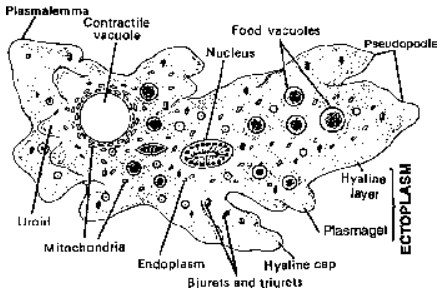
Fig. Structure of Amoeba proteus
- A. proteus discovered by Russel von Rosenhoff (1755).
- Fresh-water form found in ponds, lakes, streams etc.
- Locomotion by pseudopodia (lobopodia)
Pseudopodium at its forward end gets its firm consistency by hyaline cap which is made of ectoplasm.
Pseudopodia in Amoeba are meant for feeding and locomotion.
Locomotion with the help of pseudopodia is known as amoeboid movement.
Sol-gel theory of amoeboid movement was first given by Hyman supported by Pantin (1923) and Mast (1926). According to this theory amoeboid locomotion is due to change in the viscosity of cytoplasm.
The conversion of plasmasol into gel and vice versa is a physicochemical phenomenon.
Sol-gel transformation are due to contraction and relaxation of long chains of proteins.
∙ Nutrition - Holozoic (Omnivorous)
Amoeba ingest food by import, circumfluence, circumvallation or invagination.
Import involves passive sinking of food into body by rupture of plasmalemma, e.g., Ingestion of algae.
Circumfluence is the ingestion of less active or motionless organisms like bacteria.
Circumvallation is the engulfment of active prey like ciliate or flagellate.
Digestion is intracellular.
Food vacuole of Amoeba is analogous to the alimentary canal of an animal or gastrovascular cavity of Hydra.
The contents of food vacuole in Amoeba first becomes acidic, then alkaline.
∙ Osmoregulation by contractile vacuole.
Plasmalemma covers the body so it is in general protective in function. It is also excretory and respiratory in nature.
If an Amoeba is placed in distilled water, its contractile vacuole works faster but if it is placed in salt water, its vacuole will disappear.
Amoeba reacts to the various stimuli : It is attracted towards optimum temperature 25°C; it reacts negative to bright light, and positive to dim light; avoids solid substance, attracted by food, reacts negative to all
chemicals, moves to cathode, moves to gravity, moves along with to water current.
Reproduction - asexual by binary fission or sporulation.
Entamoeba
Belongs to order Lobosa, class-Sarcodina
E. histolytica, discovered by Lamble (1859). F. Losch (1875) discovered its pathogenic nature.
World wide in distribution but more common in the tropics and subtropics than in the temperate zone.
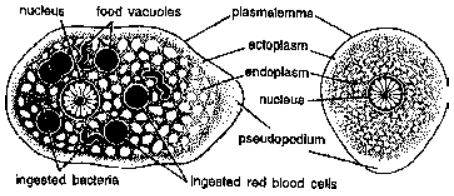
Fig. Entamoeba histolytica—Structure of life cycle
Monogenetic, endoparasite found in the mucosal and submucosal layers of the large intestine of man.
Found in 2 forms
(i) Trophozoite or Magna form - Pathogenic
(ii) Pre-cystic or Minuta form - Non-pathogenic
Reproduction by excystation, encystation & multiplication
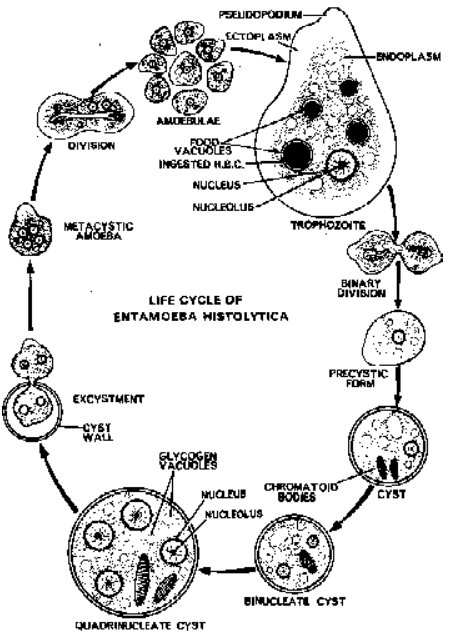
Fig. Life cycle of Entamoeba histolytica
Entamoeba has no contractile vacuole (a difference from Amoeba).
Trophozoite of Entamoeba reproduces by binary fission.
Minuta form encysts. A mature cyst is called quadrinucleate cyst. It has four nuclei and two chromatoid bodies.
The reserve food material in cyst of E. histolytica is glycogen.
Quadri (= terra) nucleate cyst is the infective stage. Infection is oral through contaminated food and water.
A single cyst of E. histolytica produces eight amoebulae.
Most effective medicine for amoebiasis is Metragyl or Flagyl.
Other species
Entamoeba coli : Non-pathogenic, endocommensal found in colon of man. It is monogenetic and infection is oral through contaminated food and water.
E. gingivalis : Non-pathogenic parasite found in tartar of teeth, aggravates pyorrhoea (doesn’t cause pyorrhoea)
Actinophrys
Belongs to order Heliozoa, class-Sarcodina.
Commonly called as sun animalcule.
Found in fresh as well as in marine water.
Naked spherical body with central nucleus, locomotory organelle - Axopodia.
Nutrition - holozoic.
Reproduction - by binary fission and paedogamy.
Noctiluca
Order - Dinoflagellata; class-Mastigophora.
Marine pelagic form; spherical body covered by pellicle.
Ventral face bears groove with an oval cytostome leading into the gullet.
Has long stout, striated tentacle and a fine flagellum.
Nucleus - single; Nutrition - holozoic; Reproduction - asexual.
Contains luciferin which emits light on stimulating by oxidation with an enzyme luciferase (Bioluminiscent).

Giardia (Grand old man of intestine)
Order-Polymastigina, class-Mastigophora.
Resides in the upper part of small intestine of man, causing abdominal discomfort and diarrhoea.
Pear-shaped, bilaterally symmetrical.
Possess double set of cell organelles like-2 nuclei, 2 parabasal bodies and 8 flagella.
Trichomonas
Order - Polymastigina, class-mastigophora. Other species -
(a) T. buccalis : found in buccal cavity of human, causes pyorrhoea.
(b) T. vaginalis : found in vagina of women, causes leucorrhoea.
(c) T. hominis : in colon by man causes diarrhoea.
Pear-shaped body supported by rod-shaped axostyle.
3-5 flagella at its anterior end.
Single large nucleus present.
Nutrition - holozoic & saprophytic
Asexual reproduction by longitudinal binary fission.
Trichonympha
Order - Hypermastigina, class - Mastigophora.
Leads symbiotic life in the intestine of termites.
Termites ingest wood but are unable to digest. Trichonympha digest cellulose by enzyme glucosidase which converts cellulose to glucose and gets food and safe lodging in return.
Trypanosoma
Order - Kinetoplastida, class - Mastigophora
Digenetic endoparasite found in the blood of vertebrates finally invading CSF causing African sleeping sickness.
Secondary host - Tse-tse fly (Glossina palpalis)
Polymorphic forms are - Leishmanial, Leptomonad, Crithidial and Trypanosomal (Metacyclic stages).
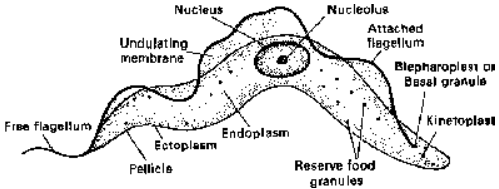
Fig. Trypanosoma gambiense
Other species :
(a) T. gambiense : causing African sleeping sickness or Gambian fever.
(b) T. rhodesiense : causes Rhodesian fever confined to east and central parts of Africa.
(c) T. cruzi : causes Chagas disease in children in South America.
(d) T. brucei : causes ‘Nagana’ disease in horses, donkeys camels and cattles.
(e) T. evansi : ‘Surra’ disease in horses, camels, cattles and dogs.
Leishmania
Order : Kinetoplastida, class - Mastigophora.
L. donovani, a digenetic endoparasite found in reticulo-endothelial system of spleen, liver, WBC and bone marrow.
Causes kala-azar or visceral leishmaniasis.
Secondary host : Sand fly (Phlebotomus argentipes)
Other species :
(a) L. tropica : causes oriental sore or cutaneous leishmaniasis or Delhi boils in man.
(b) L. brassiliensis : causes ‘Espundia’ or naso-oral leishmaniasis in South America.
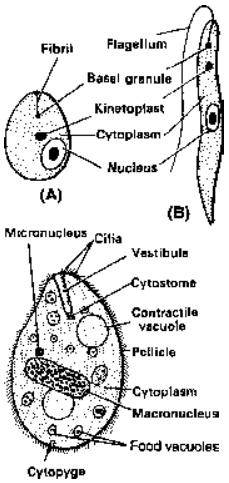
Fig. Leishmani donovani: A. Leishmania form, B. Leptomonad form Fig. Balantidium coli
Balantidium coli
Order : Spirotricha, class-Ciliata
Endoparasite in large intestine of man, monkey, frogs and pigs.
Oval body, covered by longitudinal rows of cilia.
Nutrition : holozoic
Reproduction : asexual by transverse binary fission & sexual by conjugation and encystment.
- Introduction
- Fundamentals of Animal Classification
- Body Plan and Symmetry
- Metamerism and Germ Layers
- Body Cavity or Coelom
- Protostomes And Deuterostomes
- Modern Classification of Animal World
- Five Kingdoms of Living World
- Kingdom Protista
- Protozoa
- Plasmodium
- Some Representatives of Phylum Protozoa
- Paramecium
- Phylum Porifera
- Canal System and Skeleton
- Some representatives of phylum - Porifera
- Cnidaria (Gr. Knide = nettle or stringing cell)
- Some representatives of phylum Coelentrata
- Phylum Platyhelminthes - The flat worms
- General Topics (Dugesia, Schistosoma, fasciola, Taneia solium)
- Important Points to Remember
- Phylum Aschelminthes
- Some representatives of Nematoda
- Phylum Annelida
- Polychaeta
- Oligochaeta
- Hirudinea
- Phylum Arthoropoda
- General Topics
- Important Points to Remember of Chelicerae
- Phylum Mollusca
- General Topics of Phylum Mollusca
- Important Points to Remember of Phylum Mollusca
- Phylum Echinodermata
- General Topics of Phylum Echinodermata
- Important Points to Remember of Phylum Echinodermata
- Exercise 1
- Exercise 2
- Exercise 3
- Exercise 4
- Exercise 5
- Exercise 6









